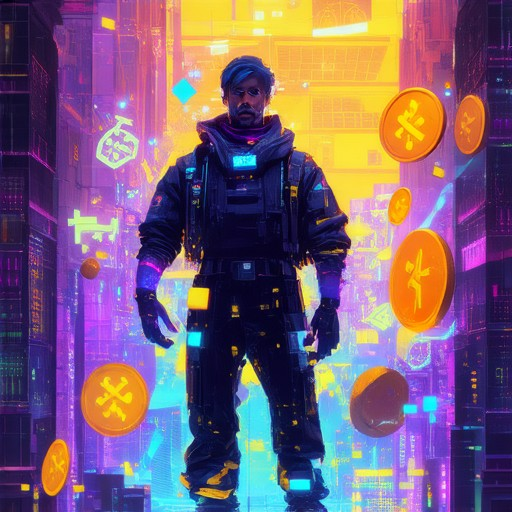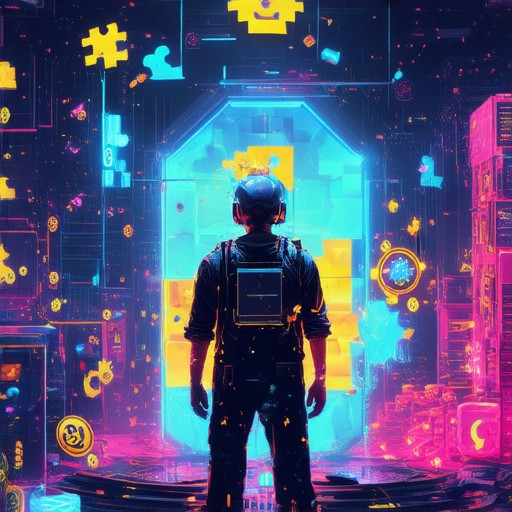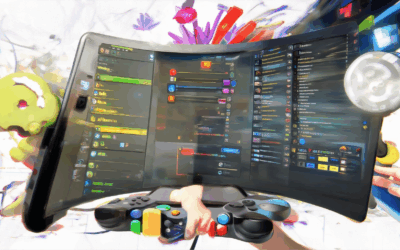In the ever-evolving world of video games, few concepts hold as much promise as creating a game that not only captivates players but also stands the test of time. For independent developers aiming to carve out a niche in this competitive landscape, the ability to craft games with inherent replayability becomes paramount. Not only does replayability ensure sustained engagement, but it also opens doors to long-term profitability, making it a cornerstone of successful game development. This guide delves into the strategies, principles, and considerations necessary to design and develop indie games that are not only enjoyable but also financially viable. From understanding the mechanics that drive replayability to exploring legal and technical aspects, we will walk you through the essential steps to create games that resonate with players and stand out in the market. Whether you’re a seasoned developer or just dipping your toes into the world of game creation, this comprehensive guide offers actionable insights and proven techniques to help you build a profitable and memorable gaming experience.
Key Takeaways
– Profitable Indie Games: Indie games can generate significant revenue, with successful titles often surpassing $1 billion in sales.
– Platform Strategy: Opting for platforms like consoles, PCs, or high-end mobile apps can maximize profitability compared to low-margin mobile apps.
– Niche Markets: Focusing on underserved genres or platforms, such as VR, AR, or educational games, can open up new revenue streams.
– Monetization Mastery: Implementing free-to-play models, subscription services, and live ops can significantly boost revenue potential.
– Independent Success Stories: Titles like Among Us and Celeste demonstrate that indie games can achieve critical and commercial success.
– Adaptation and Iteration: Regularly refining games based on feedback and market trends ensures long-term viability and player engagement.
– Tech Innovation: Leveraging emerging technologies like cloud gaming and AI-driven content can set indie games apart from the competition.
– Team Collaboration: Building a skilled team across art, design, programming, and marketing is essential for bringing visions to life.
– Global Reach: Platforms like itch.io and Steam democratize access to global audiences, enabling indie developers to scale their impact.

What Makes a Good Replayable Game?
A good replayable game is one that provides a fresh and engaging experience each time players return. Here are the key factors that contribute to a game’s replayability:
- Engaging Gameplay Mechanics :
- The core gameplay loop should be fun and rewarding. If every session feels unique due to variable mechanics or progression systems, players are more likely to return.
- Indie Dev Games often excel in creating intuitive and rewarding gameplay that encourages replayability.
- Compelling Narrative :
- A well-crafted story or world can draw players in, making them eager to explore different outcomes or paths.
- In multiplayer settings, unique characters and evolving relationships can also add layers to the experience.
- Character Customization and Progression :
- Allow players to create unique builds or characters that impact the game’s outcome. This adds depth and personalization, making each playthrough feel distinct.
- Customizable characters are a popular feature in many successful titles.
- Replayable Loops and Content :
- Mechanisms like collectible hunts, exploration, or challenges that reward persistence can motivate returns.
- Open-world games with vast maps and hidden secrets encourage exploration, fostering a desire to replay.
- Technical Reliability :
- Smooth performance and consistent functionality are critical. Players won’t revisit a game plagued by bugs or crashes.
- Ensuring compatibility across various platforms is essential for long-term success.
- Social and Community Features :
- Multiplayer modes, leaderboards, or guild systems can turn a solitary experience into a shared adventure.
- Building a community around the game enhances its longevity and appeal.
- Regular Updates and New Content :
- Providing DLCs, seasonal events, or patches keeps the game fresh and relevant.
- Regular updates demonstrate commitment and can reignite interest in older titles.
By thoughtfully combining these elements, developers can create games that captivate audiences and provide endless hours of enjoyment.
Is It Legal to Make a Game Inspired by Another Game?
Whether it is legal to create a game inspired by another depends on several factors, particularly regarding copyright law and the originality of the elements involved.
- Copyright Law Basics : Copyright protects original works, such as games, under certain criteria. However, it typically does not protect game mechanics, themes, or ideas unless they meet specific thresholds of originality.
- Game Mechanics and Ideas : In many jurisdictions, game mechanics, such as puzzles or strategies, are not considered original enough to warrant copyright protection. However, unique artistic expressions, character designs, and overall game structures may be protected.
- Moral Rights : Some countries recognize moral rights, allowing creators to object to certain uses of their work. This can extend to games, though enforcement varies.
- Fair Use : Fair use exceptions may permit limited use of copyrighted material for purposes like commentary, criticism, or parody. Fan-made games that satirize or critique another game might qualify, though this is context-dependent.
- Real-World Examples : Cases like fan-made games inspired by Minecraft have been permissible due to their simplicity, whereas copying unique mechanics may infringe on original creators.
In summary, while some game elements can be legally inspired, others may require permission. The balance lies in understanding what constitutes originality and the intended use of the inspiration. Consulting legal advice or reviewing specific cases can provide clearer guidance.

What Makes a Game Infinitely Replayable?
A game becomes infinitely replayable when it offers a unique experience each time players engage with it, encouraging them to return for more. Here are the key factors that contribute to this phenomenon:
- Engaging Storyline : A rich, branching narrative with multiple outcomes and hidden plotlines keeps players invested in exploring different paths and uncovering secrets.
- Dynamic Gameplay Mechanics : Variables such as adjustable difficulty levels, unlockable abilities, or randomized gear drops ensure each playthrough feels distinct.
- Reward System : Intriguing rewards like achievements, collectibles, or special events motivate players to revisit the game to earn these rewards.
- Challenges and Competition : Leaderboards, challenges, or competitive modes allow players to test their skills against others or their own previous performances.
- Exploration and Discovery : An expansive, evolving world with hidden locations, puzzles, or secrets encourages prolonged gameplay.
- Regular Updates and Events : New content, seasonal events, or limited-time challenges keep the game fresh and provide reasons to return.
By combining these elements, a game creates a loop that compels players to keep coming back, ensuring its longevity and appeal.

Is Creating Games Profitable?
Yes, creating games can be highly profitable, but it largely depends on several factors including development costs, target platforms, and market demand. The gaming industry is one of the most lucrative entertainment sectors globally, with revenues exceeding $200 billion annually, and it continues to grow rapidly with advancements in technology and increased accessibility through mobile devices and streaming platforms.
Key Factors Influencing Game Development Profitability
- Development Costs :
- High-quality game development requires significant investment in software, hardware, and talent. According to a report by Statista, the global game development market was valued at approximately $178 billion in 2023, with a projected growth rate of 10% annually.
- Independent developers often face challenges balancing low budgets with high-quality production values, which can affect profitability.
- Platform Dependency :
- Games developed for mobile platforms typically have lower profit margins due to revenue sharing agreements with app stores like Apple and Google.
- Console and PC games, particularly those on high-end platforms like PlayStation, Xbox, and Steam, tend to offer better profitability margins due to less revenue sharing and higher average selling prices.
- Competition and Market Saturation :
- The gaming market is highly competitive, with established giants like EA, Activision Blizzard, and Tencent dominating the industry.
- Success often hinges on unique gameplay mechanics, innovative storytelling, and strong branding. Indie developers who can carve out a niche often see significant returns, as seen with titles like Among Us and Celeste .
- Monetization Strategies :
- Free-to-play (F2P) models with premium purchases or ads are common in mobile gaming, providing steady revenue streams.
- Subscription-based models (e.g., Xbox Game Pass) and one-time purchase (OTPP) games can yield higher profits, especially for established franchises.
- Live ops, in-game events, and cosmetic microtransactions are increasingly popular ways to maximize revenue.
The Competitive Landscape
The gaming industry is saturated with both large corporations and independent studios. While big companies have significant resources and influence, indie developers are gaining traction with creative and emotionally resonant experiences. Platforms like itch.io and Steam have democratized access to audiences, allowing small teams to reach global players.
Tips for Aspiring Game Developers
- Focus on Niche Markets :
- Specialize in genres or platforms where competition is less intense but demand is consistent.
- Consider VR, AR, or educational games, which may have underserved markets.
- Iterate and Improve :
- Continuously refine your product based on player feedback and market trends.
- Build a strong community around your brand to foster loyalty and word-of-mouth marketing.
- Leverage Technology :
- Utilize cross-platform development to maximize reach and reduce costs.
- Explore emerging technologies like cloud gaming and AI-driven content generation to stay ahead of the curve.
- Build a Strong Team :
- Collaborate with experienced professionals in art, design, programming, and marketing to bring your vision to life.
- Foster a culture of creativity and experimentation to keep your team motivated and innovative.
Conclusion
Creating games can be extremely profitable, but it requires careful planning, execution, and adaptability. By targeting the right platforms, employing effective monetization strategies, and staying competitive, developers can achieve long-term success in this dynamic and rewarding industry.
Most Profitable Type of Game
When considering the most profitable type of game, several factors come into play, including audience appeal, revenue potential, and market demand. Here’s a breakdown of the most lucrative categories:
- Free-to-Play (F2P) Games: These games generate revenue through in-game purchases, ads, and optional premium features. Platforms like mobile apps and casual gaming apps dominate this category, often achieving billions in annual revenue.
- Esports (Professional Gaming): With massive spectatorship and sponsorships, esports has become a multi-billion-dollar industry. Major tournaments like the League of Legends World Championship draw millions of viewers worldwide.
- Mobile Games: Mobile apps and games account for a significant portion of app store revenue due to high download rates and frequent updates. Games like Candy Crush Saga and Angry Birds have generated billions of dollars in revenue.
- Virtual Reality (VR) and Augmented Reality (AR) Games: Early adopters in VR gaming are seeing high profit margins due to high-end hardware sales and exclusive content. Platforms like Oculus and PlayStation VR are driving this growth.
- Streaming Games and Live Events: Platforms like Twitch and YouTube Gaming have created a new revenue stream through live streaming of gaming content. Popular streamers often earn millions annually through sponsorships and donations.
Each of these categories leverages unique monetization strategies, ensuring sustained profitability. By understanding the target audience and optimizing for platforms like Indie Dev Games , developers can maximize their game’s profitability.

Can a Game Developer Become a Billionaire?
Yes, it is possible for a game developer to become a billionaire through successful entrepreneurship, innovative game design, and strategic business decisions. The gaming industry is one of the most lucrative sectors globally, with companies like Electronic Arts , Unity Technologies , and Epic Games generating billions in revenue. Here are some examples of games and developers who achieved significant success:
-
Game Dev Tycoon
In this simulation game, players can build a game development company, manage teams, and create hit titles. With the right strategy, it’s possible to grow your company into a billion-dollar enterprise.
-
Minecraft
Created by Mojang Studios , Minecraft became a cultural phenomenon and generated over $2.5 billion in revenue for The LEGO Group alone through licensing deals.
-
Fortnite
Developed by Epic Games , Fortnite transformed the gaming landscape and became a cultural icon. Its success led to a valuation of over $40 billion.
-
Call of Duty
The Call of Duty franchise, developed by Activision Blizzard , has consistently been one of the highest-grossing video game franchises, contributing significantly to its parent company’s billion-dollar revenues.
-
Tetris
Although less prominent today, the Tetris brand created by The Tetris Company has generated over $1 billion in sales across various platforms.
To achieve billionaire status, game developers often need to: – Create iconic, enduring IPs – Expand across multiple platforms (console, PC, mobile) – Leverage monetization strategies like freemium models – Build strong marketing and distribution partnerships
While success is rare, the gaming industry offers immense opportunities for entrepreneurs willing to innovate and capitalize on trends.




0 Comments